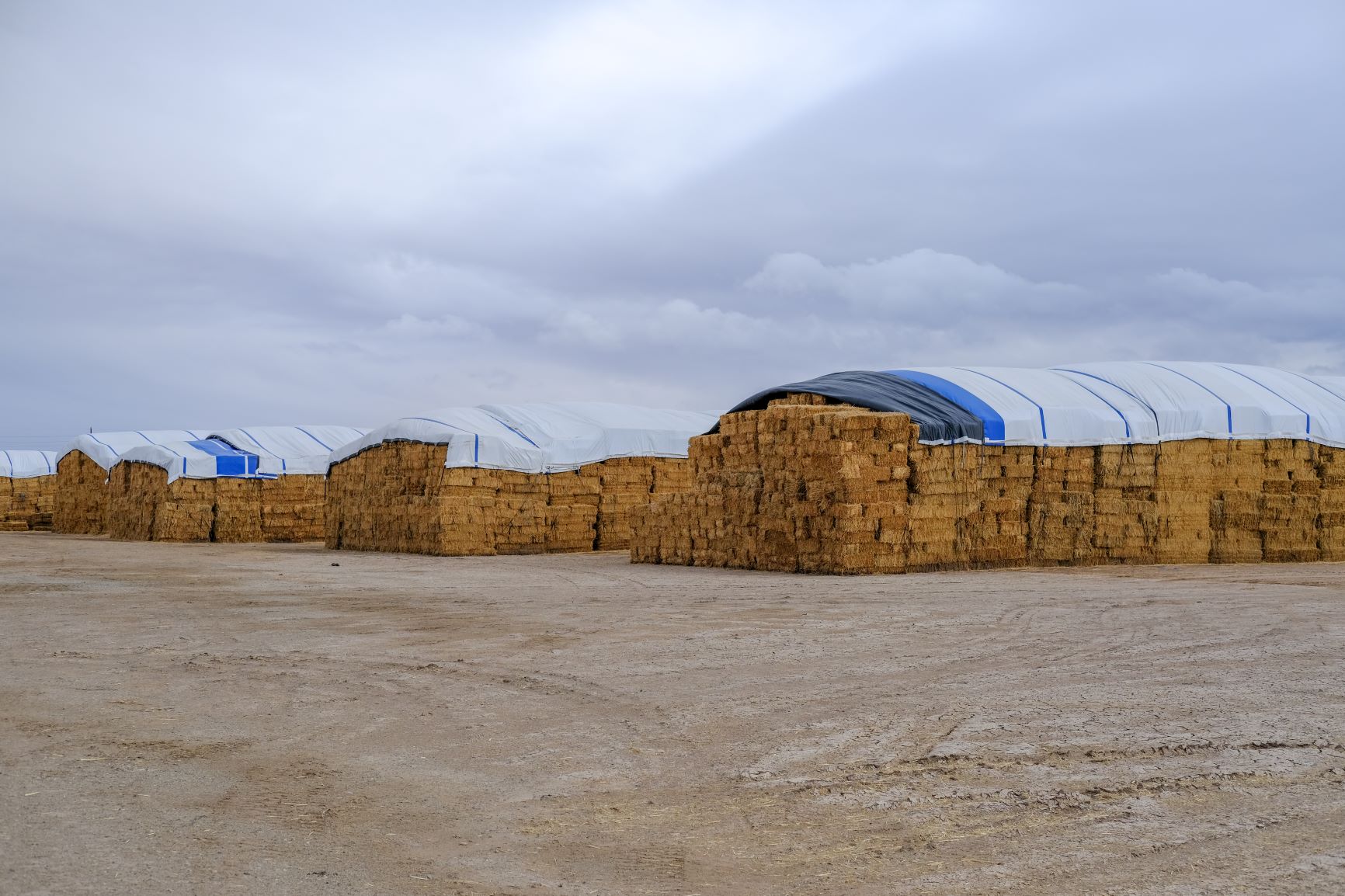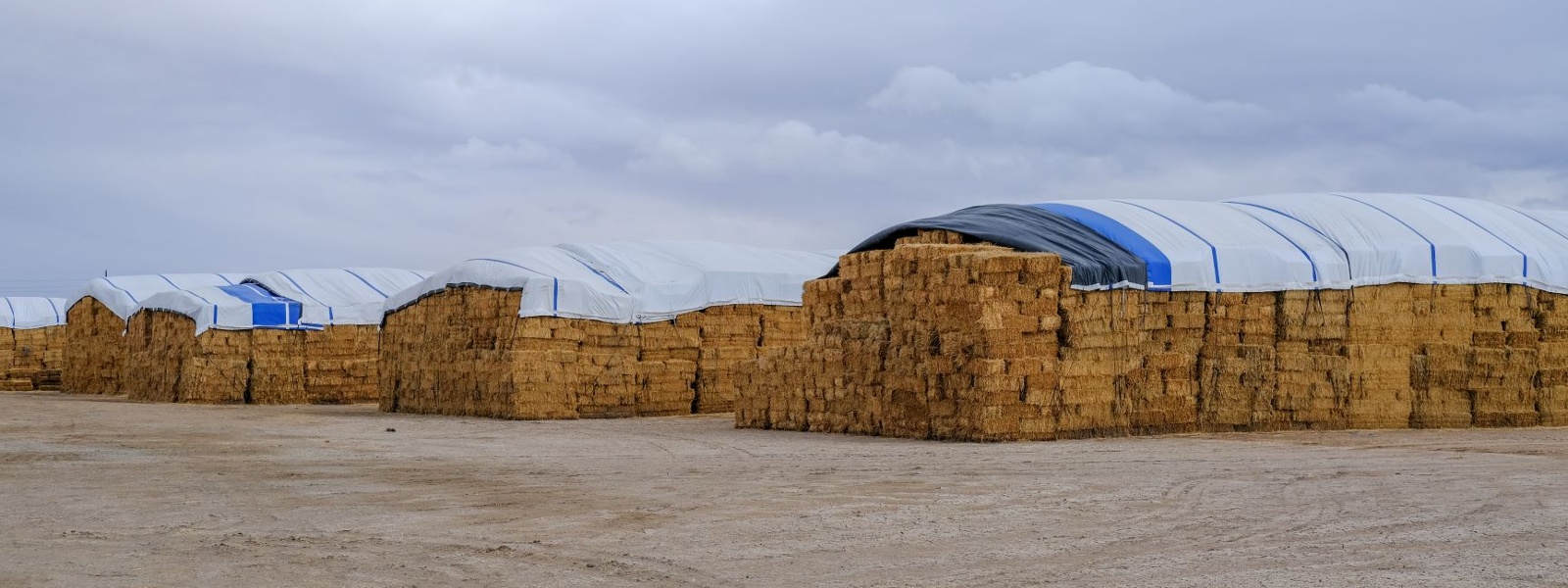Imperial Valley goes dry as farmers act to protect river

Hay bales are piled high in the Imperial Valley. Under a conservation agreement between the U.S. Bureau of Reclamation and the Imperial Irrigation District, farmers participating in a water-conservation program will be compensated for eliminating one or two forage crops a year.
Photo/Caleb Hampton

By Caleb Hampton
Irrigators cut off water to a huge portion of the Imperial Valley’s half-million acres of farmland earlier this month after the federal government approved a long-awaited program designed to bolster water levels on the Colorado River.
The conservation agreement, authorized Aug. 12 by the U.S. Bureau of Reclamation and the Imperial Irrigation District, pays farmers to stop irrigating forage crops such as alfalfa for a period during the summer. Farmers participating in the “deficit irrigation” program will be compensated to sacrifice one or two hay cuttings without—they hope—killing the perennial crops.
“Our staff has been super busy locking a large number of (irrigation) gates,” IID Water Manager Tina Shields said last week at a district board meeting. About 150,000 acres have been enrolled in the program, close to a third of the valley’s farmland and by some estimates around half the ground that is farmed in the summertime.
The landmark agreement, which capped years of negotiations and reviews, is part of a short-term effort by water users in California, Arizona and Nevada, the three states in the Colorado River’s Lower Basin, to conserve 3 million acre-feet of water through the end of 2026. The plan relies on farmers in the Imperial Valley, whose senior water rights entitle them to the largest share of the river, to come up with about a quarter of that conservation.
“IID’s efforts provide an example for other states and regions to follow as we plan for a drier future,” JB Hamby, IID vice chairman and Colorado River commissioner for California, said in a statement. “There is no excuse for inaction anywhere along the river.”
The agreement also uses federal funds to increase the compensation rate for IID’s “on-farm” conservation program, which pays farmers to install water-saving irrigation systems. Officials are aiming to incentivize more participation in that program by upping rates from $330 to $430 per acre foot of water saved. Farmers participating in the deficit irrigation program will be paid $300 per acre foot. IID will also be paid to administer the programs.
In total, the irrigation district and farmers in the valley could receive close to $700 million in federal funds over the next 30 months to leave some 700,000 acre-feet of water in the Colorado River. The monetary commitment and scale of conservation are unprecedented for the drought-ravaged river system that supplies water to 40 million people in the West.
Farmers proposed the deficit irrigation program more than a year ago and were waiting for state and federal wildlife agencies to complete an environmental review.
The agencies had raised concerns that reduced water use could cause habitat loss for endangered species that live in the marshes at the edge of the Salton Sea, which has been fed for decades by runoff from Imperial Valley farms and is shrinking as farmers conserve water. Health advocates also warned the water reductions could worsen air quality by exposing more of the inland sea’s dusty lakebed.
Authorization of the conservation agreement this month unlocked $250 million in federal funding for Salton Sea habitat restoration and dust suppression projects.
The deficit-irrigation program, initially slated to begin June 1 and last 45-60 days, was shortened to a maximum of 49 days this year due to the delayed start date running up against a Sept. 30 end date for the summer program.
After receiving approval, participating farmers wasted no time shutting off water to their crops.
“You have a real hiatus here where there’s not going to be a lot of water flowing,” said Mark McBroom, who farms in the Imperial Valley and chairs IID’s Agricultural Water Advisory Committee. “If you were to drive the Imperial Valley, it’s going to look really tough with all the fields that are brown and idle.”
Farmers in the region have long resisted fallowing as a means of water conservation because of the far-reaching impact agricultural production has in a county where one in six jobs depend on farming. But farmers said the objectives of the short-term conservation effort cannot be met solely by installing better irrigation systems.
“We just can’t ramp up that fast,” said Larry Cox, who farms in the Imperial Valley and serves on the water advisory committee.
Cox said drying up forage crops in the summer months, when water demand is highest and yield and quality tend to be poorest, is an attempt to “thread the needle” of meeting the conservation goals without cratering the local economy.
The program could sideline harvest crews for some workdays, Cox said, but overall it would have “a minimal impact on our community and farm service providers” compared to year-round fallowing.
Enrollment in the first-of-its-kind program was likely boosted, farmers said, by rock-bottom hay prices that made it more attractive for growers to take a payout and skip one or two low-earning cuttings.
“It’s not a secret that our markets have taken a tumble,” said Cox, who enrolled about 70% of his acreage in the program. “The price we’re receiving for our alfalfa and our Bermuda grass and Klein grass is not much higher than the cost of baling it at this point.”
Because of the seniority of the Imperial Valley’s water rights, the region has so far shared and conserved water through voluntary programs, with farmers making business decisions on whether to participate. Next summer, “if things turn around and you start seeing forage prices where they were at two years ago, you may not get folks who are in the program this year wanting to forgo those cuttings,” McBroom said.
There are no guarantees how the program will pencil out for farmers.
“This is a big unknown,” Cox said, the biggest uncertainty being how well the crops will hold up over six weeks without water during the valley’s scorching summer. “Those plants are going to be extremely stressed. When we water them back, we don’t know whether they’re going to come back or they’re going to die.”
Having to reseed and reestablish the crops could make the initiative, despite the payments, prohibitively costly for farmers.
“You need to be very careful on this,” said Ali Montazar, University of California Cooperative Extension irrigation and water management advisor, who conducted a three-year study on deficit irrigation with Imperial Valley alfalfa farmers. “If we do a bad job, we can lose the plant stands and lose plant population.”
Even if the plants recover, McBroom said he is not counting on baling much hay for the rest of the calendar year due to the time it could take to rehabilitate the crops. That could make a dent in production.
“When you’ve got that amount of forage acres being sidelined,” he said, “I would anticipate the inventories of our hay being produced in the Imperial Valley going down a lot.”
(Caleb Hampton is an assistant editor of Ag Alert. He may be contacted at champton@cfbf.com.)




